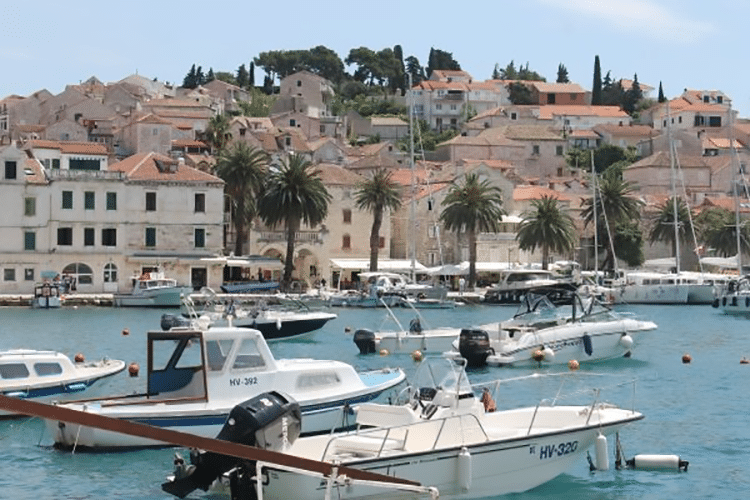Croatia proves that cartographers have a sense of humor. Boomeranging up the Adriatic Sea into the Balkan Peninsula, the chevron-shaped nation, long a part of this empire or that coalesced out of the disintegration of Yugoslavia, and it did not prevail without a monumental fight. But good things are worth fighting for. And what the Croats won was a country all their own, but with two very different souls: the continental interior, land of imperial grandiosity, and the coastal region of Dalmatia, whose island studded shores could have drifted out a Renaissance fantasy.
In Croatia, all roads lead to Zagreb, deep in the country’s Balkan arm. Like any city, there is an “uptown” and “downtown,” but Zagreb takes it literally. Both are references to elevation and also defense. Two hilltop communities, Kaptol and Gradec, form the original medieval nucleus; the lower section tentatively appeared only when it was safe to come down after the pillage happy Mongols departed circa 1242. When the Belle Epoch swept into Zagreb on the rails of the fabled Orient Express in the 1800s this part at last took recognizable shape. Then, the city became a destination.
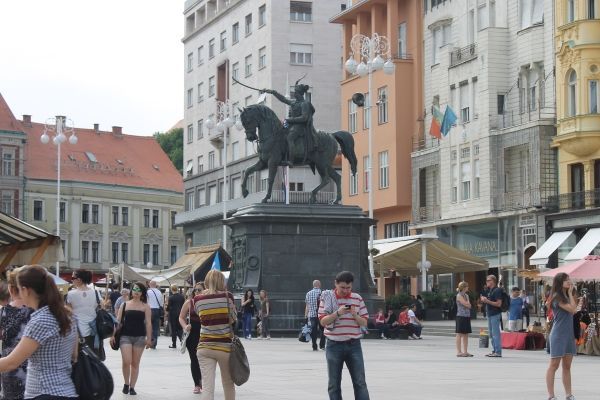
Grand promenades, stately manors, tree-lined squares — this corner of Austro-Hungary reinvented itself as Paris-in-miniature, and for visitors today, the city is a Zagreb-sized window to the glamour days of empire. Strolling amid the ancient sycamores marking the Neo-Baroque symmetry of Zrinjevac Park, gazing up at the cobalt yellow pediments of the Art Pavilion, and taking in the exhibits at the Mimara and Archeological Museums (both housed in Neo-Renaissance palaces), I found a city beautiful inside and out. What I couldn’t find was a hint that 20 years ago it was a war zone, or 30 years ago a grim outpost of communist-era apartment blocks.
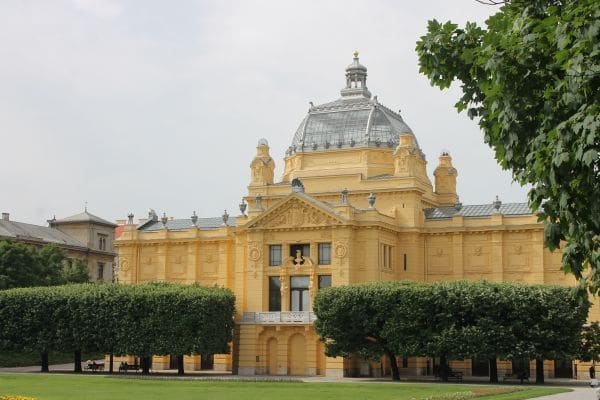
Change also came to Medveščak Creek — it no longer exists. Urban renewal at its finest, it was covered up, bloody bridges and all, in 1898 and reborn as Tkalčićeva Ulica, the super-fun night street of Zagreb. Lined end to end with bars and restaurants specializing in the local brandy (called “šljivovica,”) and zagorski štrukli, a type of cheese dumpling that is the national nosh, Tkalčićeva is alive with food, techno and herds of tipsy beautiful people.
Back in the centre at the entrance to Gradec, the Stone Gate is emblematic of the city as is the cathedral, whose lofty towers can be seen from just about anywhere in town. Petite compared to other grand churches, the sanctuary looms large in the Croatian national psyche as the resting place of Cardinal Archbishop Aloysius Stepinac, murdered in 1960 when he proved he could be as much a thorn in the Nazi’s side during their occupation as he could the communist government that followed.
I decided to head to the coast where Croatia’s multiple personalities show. You would never know that the coastline is over 1000 miles of real estate thanks to the lock Dubrovnik has on the public sphere. And well it should. Its original city wall is intact, its fortresses stunning, and its streets host Game of Thrones sets. Put this all together and you have a city that has sold itself down the river of over commercialization. That is why I left and pushed on for Hvar.
That’s not to say that Hvar isn’t itself a bit of a fantasyland.
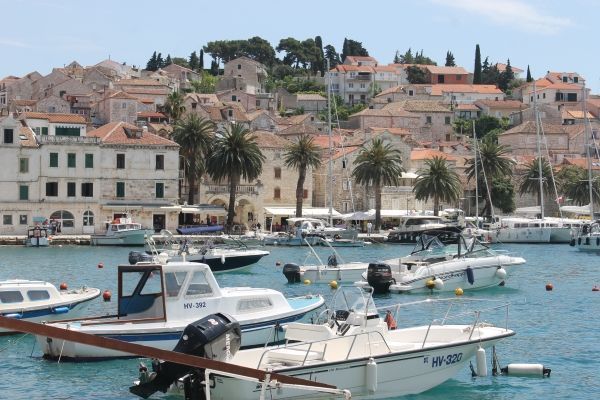
Parties! Parties! Parties! The darling of Dalmatia, from June to August, Hvar’s pedestrian traffic is bumper to bumper. Divino, Nautica, Riva’s, and the BB Club — what in winter are sleepy bars and tavernas tucked into the harborside and alleys transmogrify into the hippest places on Earth. The šljivovica goes down, the decibel level of trance music goes up, and when last call hits at 2 AM, the party people up to the islands offshore and keep the good times going well into dawn. If rubbing shoulders with Europe’s glamour gang does it for you, welcome to paradise.
But Hvar has become a curious victim of its own success. The glitterati are so beholden to Hvar’s June to August season that they don’t go at any other time. Go in May or September or even April or October and the sea is still crystalline, the weather still glorious, and the natives still friendly, but what you find is what Hvar really is – a charming fishing village on the edge of an eponymous island looking out over the Adriatic Sea … with lower prices.
Hvar begs to be explored. The huge town square, opening onto the harbor, is the centerpoint of a maze of lanes. One leads to a grand palace of balconies, now the town library. Another winds to Nonica’s, the best patisserie in town. But walking through the warren, I was reminded not of Zagreb and its continental sumptuousness, but of something you might find across the Adriatic in sundrenched Italy, what with the narrow alleys shaded by boxy buildings and low-angled tiled roofs. Of course that may have less to do with the climate than with the fact that Dalmatia was for 500 years under the control of the Venetian Republic, more than enough time to leave a mark.
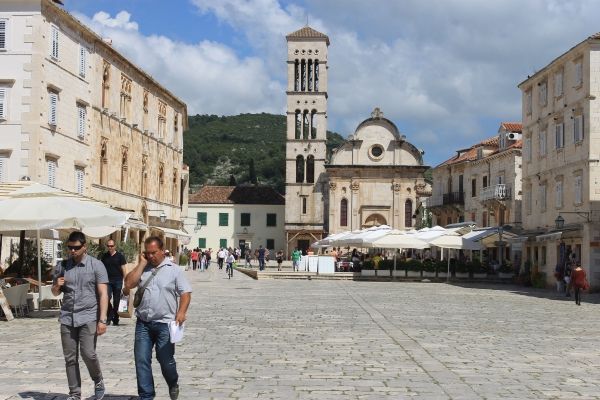
But it is Šibenik that really leaves a mark. On the mainland at the mouth of the Krka River, with the islands of the Zadar Archipelago dappling the sea in the distance, Šibenik is a medieval squiggle of horse-and-buggy-wide lanes worn to a treacherously smooth finish by a thousand years of footfalls. A city of staircases (you’re either walking up or walking down), it’s one of those rare finds where getting lost is the best thing to do; a meandering stroll leads to secluded courtyards, intimate tavernas, the gardens at the St. Lawrence monastery, even an aquarium.
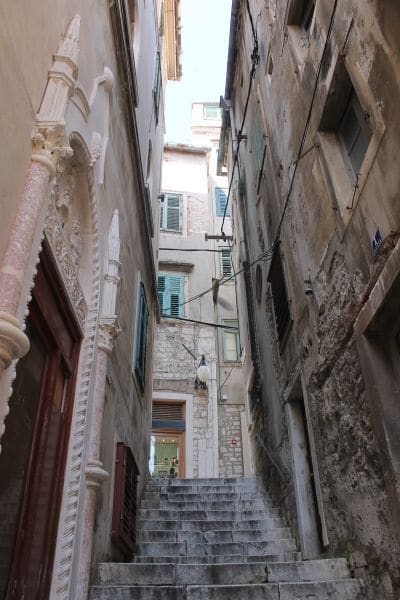
Hewn from sugar white marble, the town is a particularly dazzling experience in daylight. For those who forgot to pack sunglasses, the tenebrous depths of the Cathedral of St. James the Greater offers relief. Chapels spangle the city, but most are one room, bunker-like affairs. Built in 1431 and decorated by Georgius Mathei Dalmaticus (only the greatest artist of the 15th century), St. James is impressive: lined with gilded altars and sarcophagi, the thick walls, barrel vaults, and multitude of carved heads hide the fact that no mortar was used in the construction, making the structure unique.
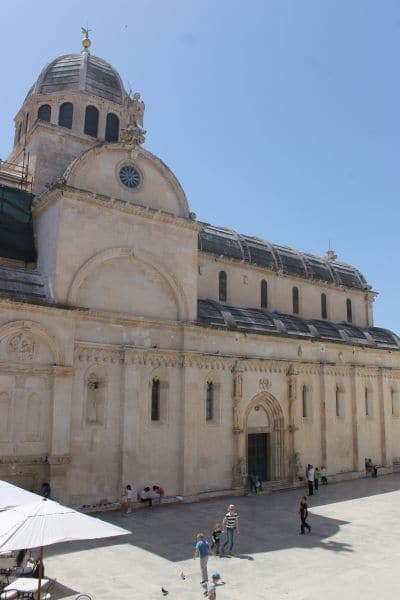
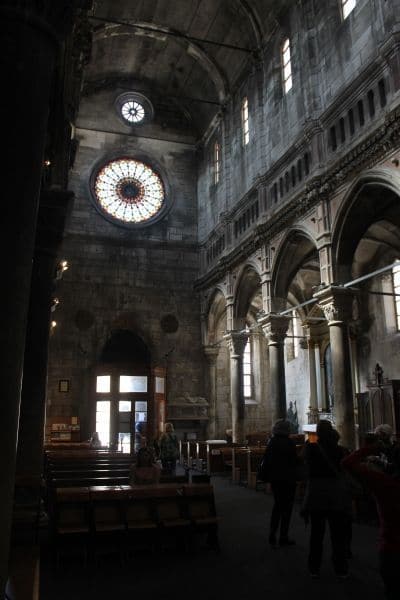
Opposite the cathedral across the main plaza is a loggia heralded as the most beautiful in the country and serving as city hall, in more ways than one. The colonnaded first floor is Gradska Vijecnica, an eatery whose name means “City Hall” and it’s a fine introduction to Dalmatian cuisine (hope you like fish, and figs). It’s also a grand reveal to the best kept secret of Croatian oenophilia. The country is one of the Mediterranean’s best wine regions, but the wineries are all modest, family-run, and qualify as boutique. Sommeliers often contract with these highly individualized vineyards to provide their wines, meaning the one you get at a particular restaurant may be the only place in the world where you can get it.
And that is the real charm of Šibenik … sitting back under an Adriatic sun in an ancient courtyard with a glass of wine you can get nowhere else and letting the life of the town play out; children chasing pigeons in the square, adults showing off their prowess with a soccer ball, and everybody enjoying the day.
I ended my journey in Split, retracing another’s ancient footsteps. Roman emperor Diocletian did the same when he retired to a grand palace built there in 305 AD. A few things have changed since. In the Byzantine timeline of the Balkans, fraught with wars and sackings, the put-upon Greek colony of Aspalathos “moved” into the palace, effectively turning it into the city that would become Split. Nearly 9,000 people once jostled for space in a structure just 10 acres in area. Nothing went to waste as the city grew in, around, over, and through the original Roman buildings; the palace walls became the city walls, the peristyle became the town square. Even Diocletian’s mausoleum was appropriated, becoming the Cathedral of St. Domnius (ironic considering Diocletian massacred more than a few Christians).
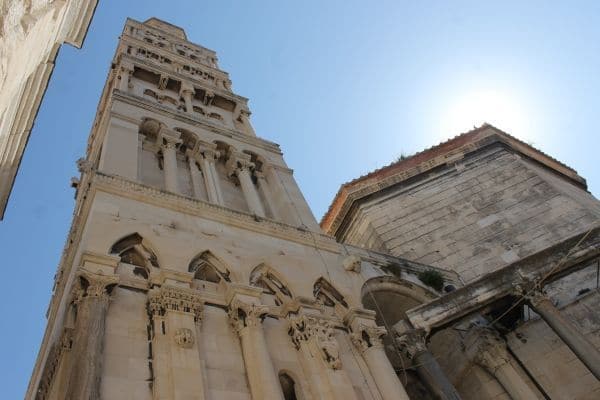
Today, the palace only hints at its original open, airy layout, even the wide boulevards of Diocletian’s day are now a bird’s nets of narrow lanes, the result of the Splićani wringing out as much living space as they could. The cramped quarters have a method; they keep people in the shade. From the bell tower of St. Domnius, sunny Split is all roofs, no street.
The largest city on the coast, Split is much faster paced than Šibenik and even Hvar. The throngs of tourists hoping to catch a glimpse of Diocletian — or a roaming Game of Thrones filming crew — certainly keep the Roman soldiers in the square busy. But I sat off to the side and decided to sip a glass of wine which I could get only from the bar just off the square. Overlooking me was a sphinx, and across the way was the balcony where Diocletian held audience. And I toasted the man who knew a good thing when he saw it.
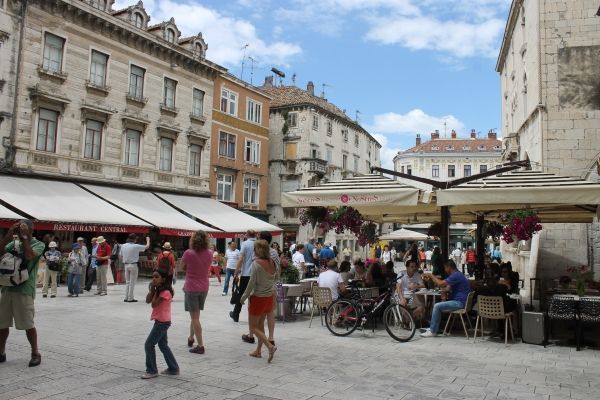
The country code for Croatia is 385.
[alert type=white]
Where to Stay:
Best Western Astoria — Stay here and everything you want to experience in Zagreb is within walking distance. Being in the city center makes everything a little cozy, but architects maximized the luxurious potential of minimum space. Petrinjska 71, 10000 Zagreb; +385 1 480 89 00; www.bestwestern-ce.com/bwc/hotel.ct?hotelId=89502
Esplanade Zagreb Hotel — In Zagreb, this is the prestige address. Made for Orient Express travelers, the serious luxury overload has the added punch of being next to some of the best parks in the city. Mihanoviceva 1, 10000 Zagreb; +385 (0)1 456 6666; www.esplanade.hr
Solaris Beach Resort — A sprawling complex of hotels near Šibenik, the seaside Solaris, besides being lauded for its accommodations and spa, has on-site a recreation of a traditional Dalmatian village. Far from a glamorized version of medieval life, the Dalmatian Ethno Village is an accurate mirror of what life was like in a vanished Dalmatia, right down to the brandy stills. Hotelsko naselje b.b., 22000 Šibenik; +385 22 361 001; www.solarishotelsresort.com
Le Meridien Lav — Set outside Split’s historic Venetian-Roman center, uber classy Le Meridien is all about refinement and the European good life. Right on the water, with glorious dawns coming over the Dinaric Alps and coral colored sunsets on the Adriatic, the property also has a private beach. Grljevačka Ulica 2, 21312, Split; +385 21 500 500; www.lemeridienlavsplit.com
Where to Eat:
Agava — In the heart of 24 hour party street Tkalciceva Ulica, this eatery can start or end the night. Bars, pubs, and clubs surround the place. Built into the hillside, you can opt to dine at street level, or people watch from the veranda. Tkalciceva Street nr. 39, 10000 Zagreb, Croatia; +385 (0)1 482 9826; restaurant-agava.hr
Tinel — Set in a church courtyard and shaded by an ancient tree that probably has more than one story to tell, Tinel is one of the best places in Šibenik to sample Croatian wine and the figs soaked in Croatian wine. Forever tied to the sea, the fish is your best bet; it will have been caught hours, if not minutes, before. Trg Puckih Kapetana 1, Šibenik; +022 331 815
Skala — Overlooking the Krka River marina below Krka Falls, the rich, beefy, spicy menu tells you this was Turkish territory. A bit hard to find, but don’t miss this place. Rokova 7, Skradin; +385 22 771 081; www.tripadvisor.com
Kod Kapetana — On the far side of the Hvar harbor, Kod Kapetana gives an unmatched panorama of the town, square, church, and mountaintop fortress. Nothing is far from anything in Hvar, and a walk from the always bustling square to the restaurant means a sidewalk tour of palaces, tiny chapels, and timeless ocean views. If you detect the scent of lavender, you aren’t imagining it. Hvar is one of the best places on Earth to get the stuff. Fabrika b.b., Hvar, Hvar Island, 21450, Croatia
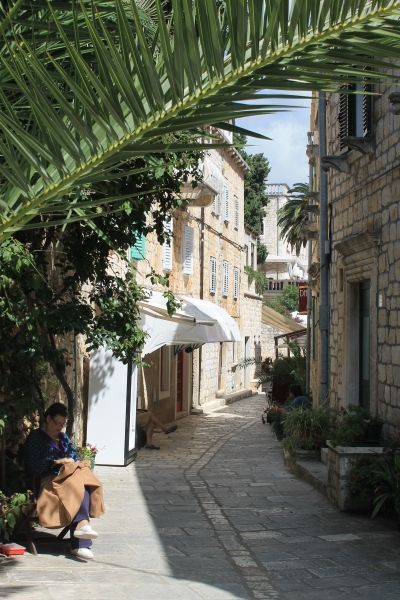
What to See & Do:
Krka Falls — About an hour north of Šibenik, the Krka River seemingly loses its sense of direction, and so takes all of them. But there is a bit science to what looks like the aqueous equivalent of a tantrum. To limestone, which forms the bed of the river from start to finish, water is an acid. As it runs its course, the Krka dissolves more and more material into itself, until, at the falls, the water reaches a critical saturation point and the minerals begin to precipitate out, crystallizing in the form of travertine on the banks, tree roots, deadfall, and anything else handy to form huge terraces. In some places it builds up so much the river dams itself, forms a new pool, a new outlet, and another set of falls. The result is a verdant fairyland of step-like tiers that turn a placid river into a ziggurat of white-water. Trg Ivana Pavla II. No.5, 22000 Sibenik; +385 (22) 201 777; www.npkrka.hr/
Kornati National Park — Who knew a ferry could take you to another planet? Several of the islands off the coast of Croatia are so dry, they qualify as desert and are only inhabited during the summer, or just long enough to tend the multitude of vineyards. At the resort town of Murter, the earth seems to fly apart in a smattering of pinnacles and from here you can ferry out to tiny fishing villages like Vrulje and seasonal eateries like Gostionica Klif. Prepare to be dazzled by the seascape’s endless shades of blue. Rent a boat or spring for a tour and spend the day but don’t expect to find any sandy beaches. The Mediterranean has no tidal action to make sand, so the islands jut straight from the water to dramatic effect. Butina 2, 22243 Murter; +385 (22) 435740; www.kornati.hr/en
Museum of Broken Relationships — Yes, we’re not kidding! Located in the Gradec part of town, could this perhaps be Zagreb’s most donated-to museum? The tasteful space, actually an old palace, is filled with Dear John letters, wedding dresses, tuxedoes, broken glass, and all sorts of thrown objects that demonstrate that your former flame was a total psycho. Ćirilometodska ulica 2, 10000, Zagreb; +385 1 4851 021; www.brokenships.com/
Skradin — Just downriver by boat from Krka Falls, Skradin has a different feel than other Dalmatian towns. While the coast was Venetian, the interior was Ottoman, and Skradin, with its onion domes and Turkish fort, has an Oriental air to it. At the dock are rows of tchotchke shops filled with woodwork that may look a bit “much” when you see it all together, but trust me; one piece will ooze European sophistication back home on your coffee table as a solo act. www.skradin.hr/en/
Trogir — Midway between Šibenik and Split, Trogir has the charms of both. A bit more cosmopolitan than Šibenik, resort-y Trogir is actually a town that sprung from an island. Geography being a funny thing, it is only 10 or so feet from the Croatian mainland, but that distance was the jagged edge between Christian Venice and the Muslim Ottoman Turks for centuries. While wandering the town look for grooves carved into the outside corners of buildings which denote the owners’ wealth and status – the higher it goes the wealthier. www.trogironline.com/
Trogir Town Square — Nab a table at one of the cafes and wait. Every hour or so, an a cappella group singing traditional songs of love and valor serenades visitors from the loggia across the square from the church.
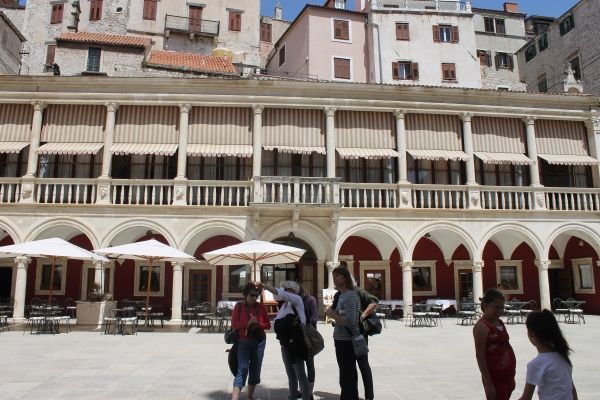
[/alert]

